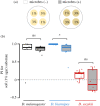Drosophila suzukii avoidance of microbes in oviposition choice
- PMID: 33614092
- PMCID: PMC7890486
- DOI: 10.1098/rsos.201601
Drosophila suzukii avoidance of microbes in oviposition choice
Abstract
While the majority of Drosophila species lays eggs onto fermented fruits, females of Drosophila suzukii pierce the skin and lay eggs into ripening fruits using their serrated ovipositors. The changes of oviposition site preference must have accompanied this niche exploitation. In this study, we established an oviposition assay to investigate the effects of commensal microbes deposited by conspecific and heterospecific individuals and showed that the presence of microbes on the oviposition substrate enhances egg laying of Drosophila melanogaster and Drosophila biarmipes, but discourages that of D. suzukii. This result suggests that a drastic change has taken place in the lineage leading to D. suzukii in how females respond to chemical cues produced by microbes. We also found that hardness of the substrate, resembling that of either ripening or damaged and fermenting fruits, affects the response to microbial growth, indicating that mechanosensory stimuli interact with chemosensory-guided decisions to select or avoid oviposition sites.
Keywords: Acetobacter; Gluconobacter; acetic acid bacteria; decision-making; mechanosensory stimulus; spotted-wing Drosophila.
© 2021 The Authors.
Conflict of interest statement
We declare we have no competing interests.
Figures



References
-
- Walsh DB, Bolda MP, Goodhue RE, Dreves AJ, Lee J, Bruck DJ, Walton VM, O'Neal SD, Zalom FG. 2011. Drosophila suzukii (Diptera: Drosophilidae): invasive pest of ripening soft fruit expanding its geographic range and damage potential. J. Integr. Pest Manag. 2, G1–G7. (10.1603/IPM10010) - DOI
Associated data
Grants and funding
LinkOut - more resources
Full Text Sources
Other Literature Sources
Molecular Biology Databases

